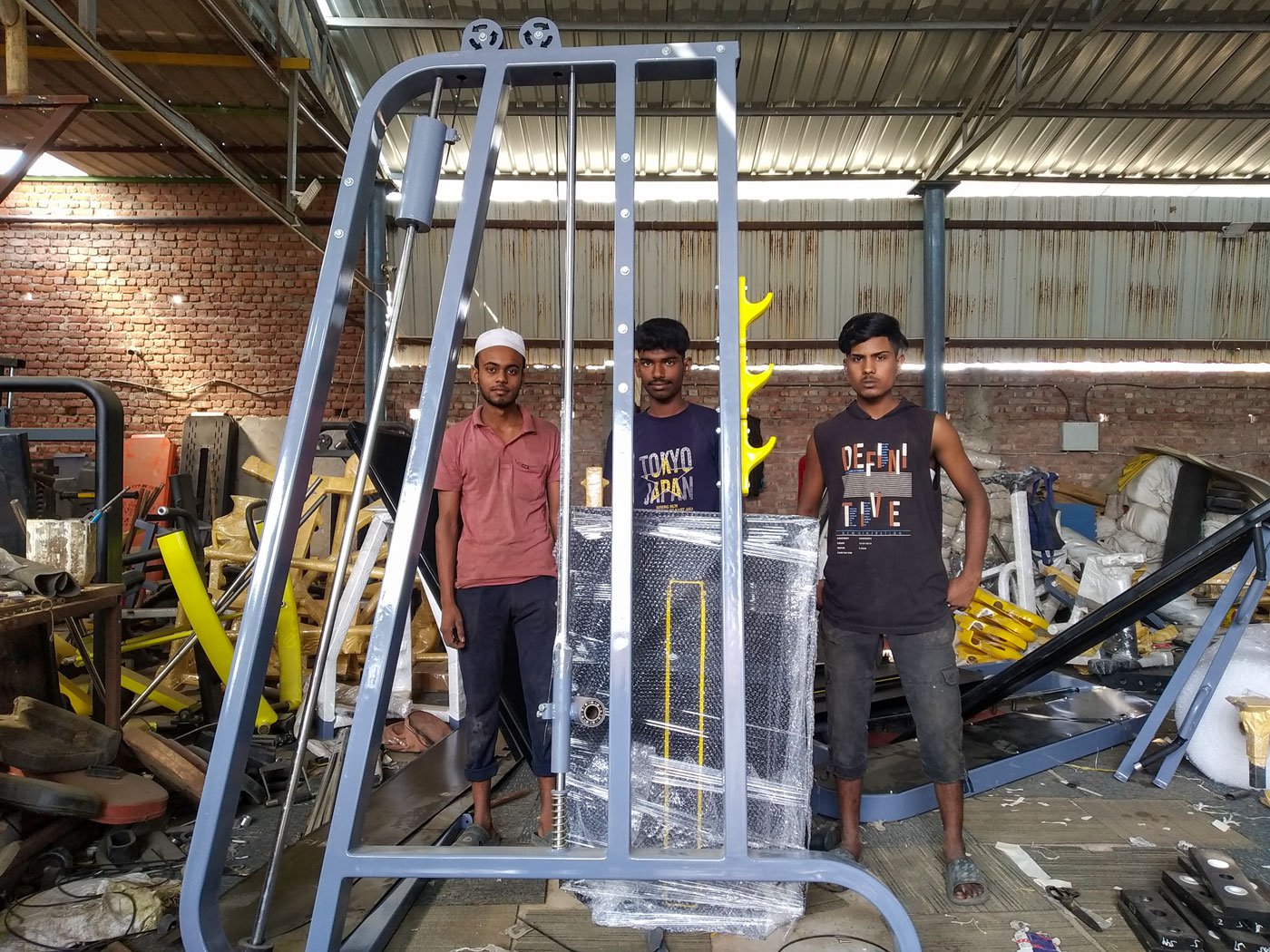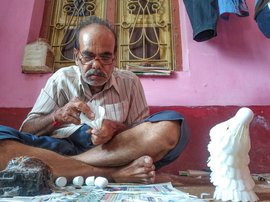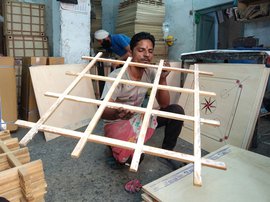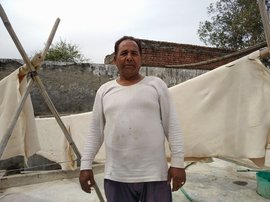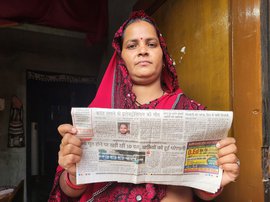“I got six pack abs just like that, I have never exercised. And look at Shahbaz’s biceps!” says young Adil, laughing as he points to his co-worker.
Mohammad Adil and Shabaaz Ansari are workers in Meerut’s gym and fitness equipment industry, and they lift more weights in a day than gym goers do in a week. This heavy lifting is not a fitness aim, but an important livelihood available to young men from Muslim families in Meerut city of Uttar Pradesh. In fact, this entire district in western UP is a hub for sports goods’ production.
“Just a few days ago,” says Mohammad Saqib, “the boys were doing a photoshoot to compare their biceps and abs [abdominal muscles].” An entrepreneur, the 30-year-old Saqib is sitting behind the counter in his family’s rented gym equipment showroom on Suraj Kund Road, a kilometre-long stretch that is the centre of the sports goods market in Meerut.
“From a simple dumbbell used by homemakers to complicated setups used by sports professionals, everybody wants gym and fitness equipment today,” he adds.
As we speak, several electric three-wheelers (locally known as mini metro) enter and exit the busy road, loaded with iron rods and pipes, as well as finished products like a home gym and iron bars. “Gym machines are made in parts and assembled later,” explains Saqib as he watches the traffic of iron goods through the glass door of the showroom.
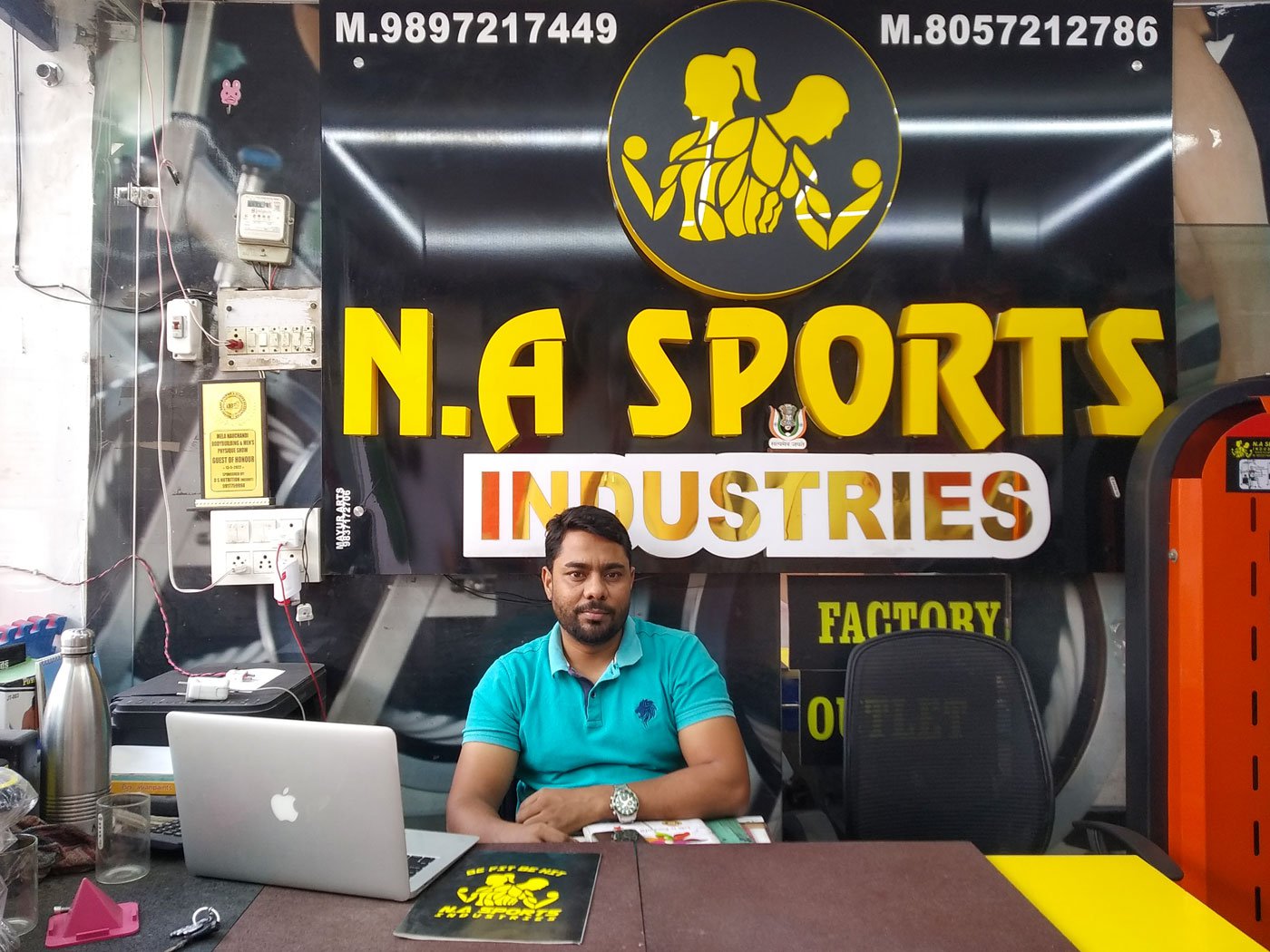

Left: Mohammad Saqib at their rented gym equipment showroom on Suraj Kund Road in Meerut city . Right: Uzaif Rajput, a helper in the showroom, demonstrating how a row machine is used
Meerut’s pole position for iron works is not new. “The city is world famous for its kainchi [scissor] industry,” Saqib tells PARI. In 2013, Meerut’s scissors, an industry almost three centuries old, made the cut for a Geographical Indications (GI) tag.
Manufacturing gym equipment in Meerut though has a more recent history, dating back to the early 1990s. “Punjabi entrepreneurs and a few other well-established local firms in the district’s sports goods industry were the ones to take the lead,” Saqib says. “Skilled iron-workers were already here and raw materials like recycled iron pipes, rods and sheets for gym equipment-making were also easily available in the loha mandi [wholesale raw material marketplace] in the city.”
Most of the ironsmiths and iron-casting workers ( lohe ki dhalai karne waale ) are Muslim and come from low-income households. “The family’s eldest male child gets trained at a very young age,” Saqib says. “Members of the Saifi / Lohar (Other Backward Class) sub-caste are believed to be highly skilled in this occupation,” he adds. Saqib’s family belongs to the Ansari community, a Muslim sub-caste of weavers, listed as OBC in the state.
“Many units are located in Muslim-majority neighbourhoods like Islamabad, Zakir Hussain Colony, Lisadi Gate and Zaidi Farm,” says Saqib. Meerut district has a Muslim population of around 34 per cent – the seventh highest in the state (Census 2011).
The largely Muslim profile of the iron workers here is not peculiar to Meerut alone. As per the 2006 Report on the Social, Economic and Educational Status of the Muslim Community of India ( Sachar Committee Report ), fabricated metal products are amongst the three manufacturing segments in which a relatively large proportion of workers are Muslim.
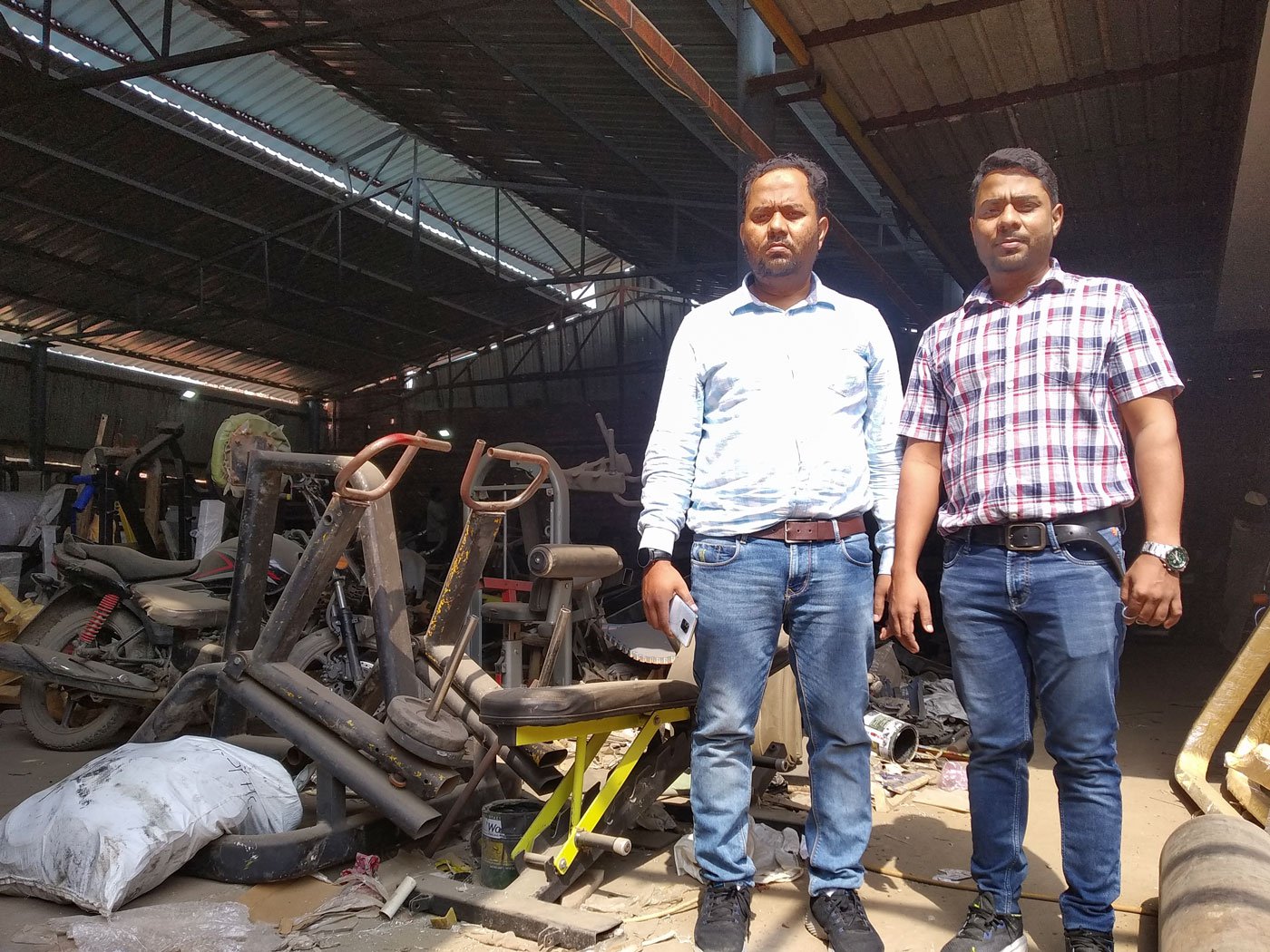
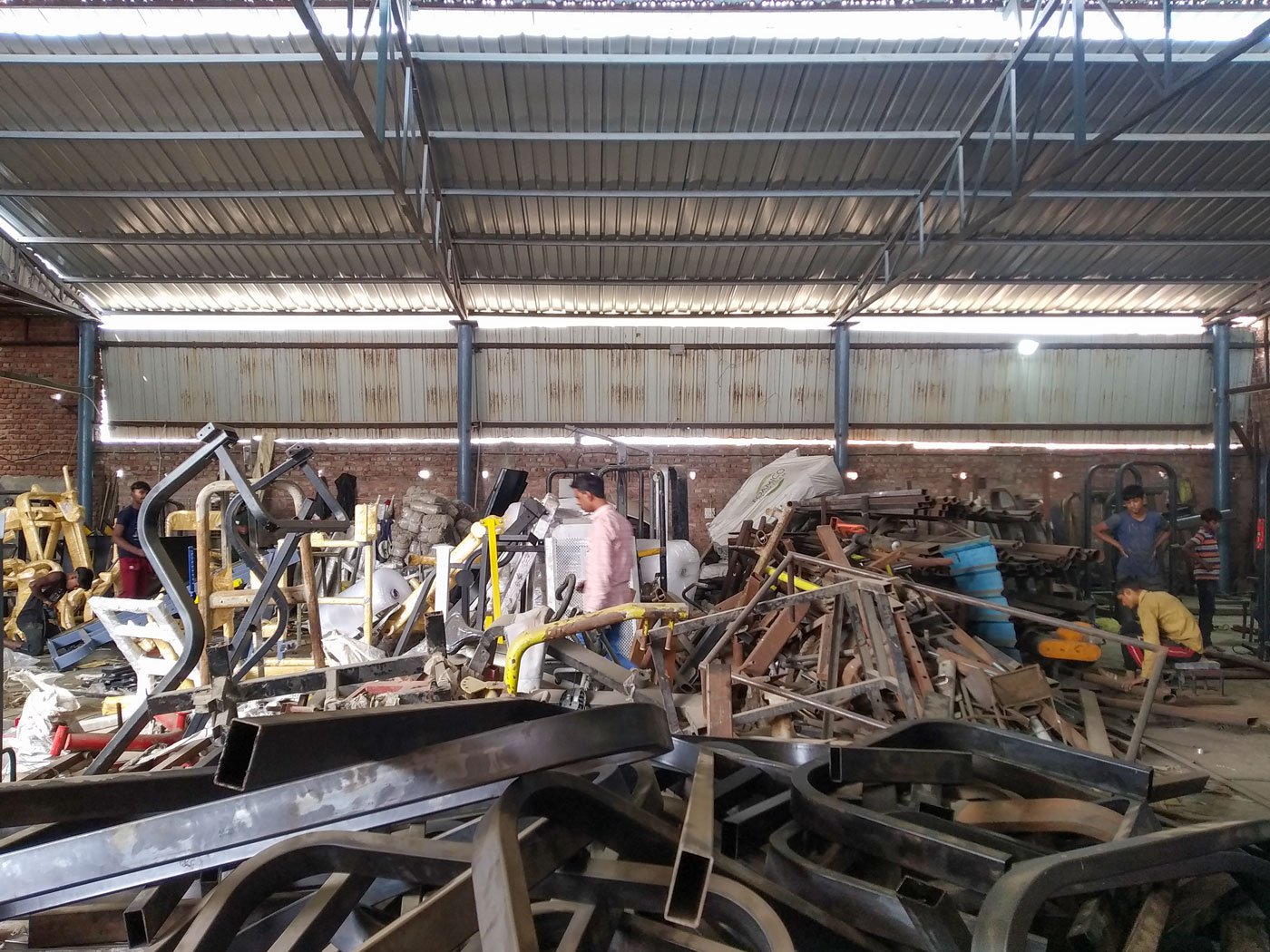
Asim and Saqib in their factory at Tatina Sani.
Not just Meerut city, but this entire district in western UP is a hub for sports goods’ production
Saqib and his brothers Mohammad Nazim and Mohammad Asim, both in their mid-thirties, started off as workers in the city's iron industries. They were young boys when their father’s wholesale fabric business suffered heavy losses in the early 2000s, and so they went to work.
Asim started making dumbbell plates at home in Ahmed Nagar locality while Nazim worked in an auto parts manufacturing business. Saqib worked as a helper to master karigar Fakhruddin Ali Saifi in a metal fabrication karkhana (factory). “He taught me how to make different kinds of structures like gym equipment, jhoole [swings] and jali gates [lattice-work gates] by cutting, bending, welding and assembling metals,” Saqib says.
Now, the brothers run their own fitness and gym equipment-making factory in the village of Tatina Sani, a small settlement located around nine kilometers from their showroom in the city. Meerut is a hub for iron artifacts manufacturing as well – tools, scissors and iron furniture are amongst the main items exported from the district (Census 2011).
“There are many many skilled iron-workers in Meerut who know much more than me. The only difference is that I have been able to become an employer from a labourer, and most have not,” says Saqib.
His journey was made possible due to an opportunity he got to pursue a Masters in Computer Applications (MCA) with the money his brothers had saved up. “My brothers were hesitant at first, but also confident that the knowledge I had gained in my MCA would help us in setting up our own business in the established gym and fitness equipment industry,” Saqib says.
*****
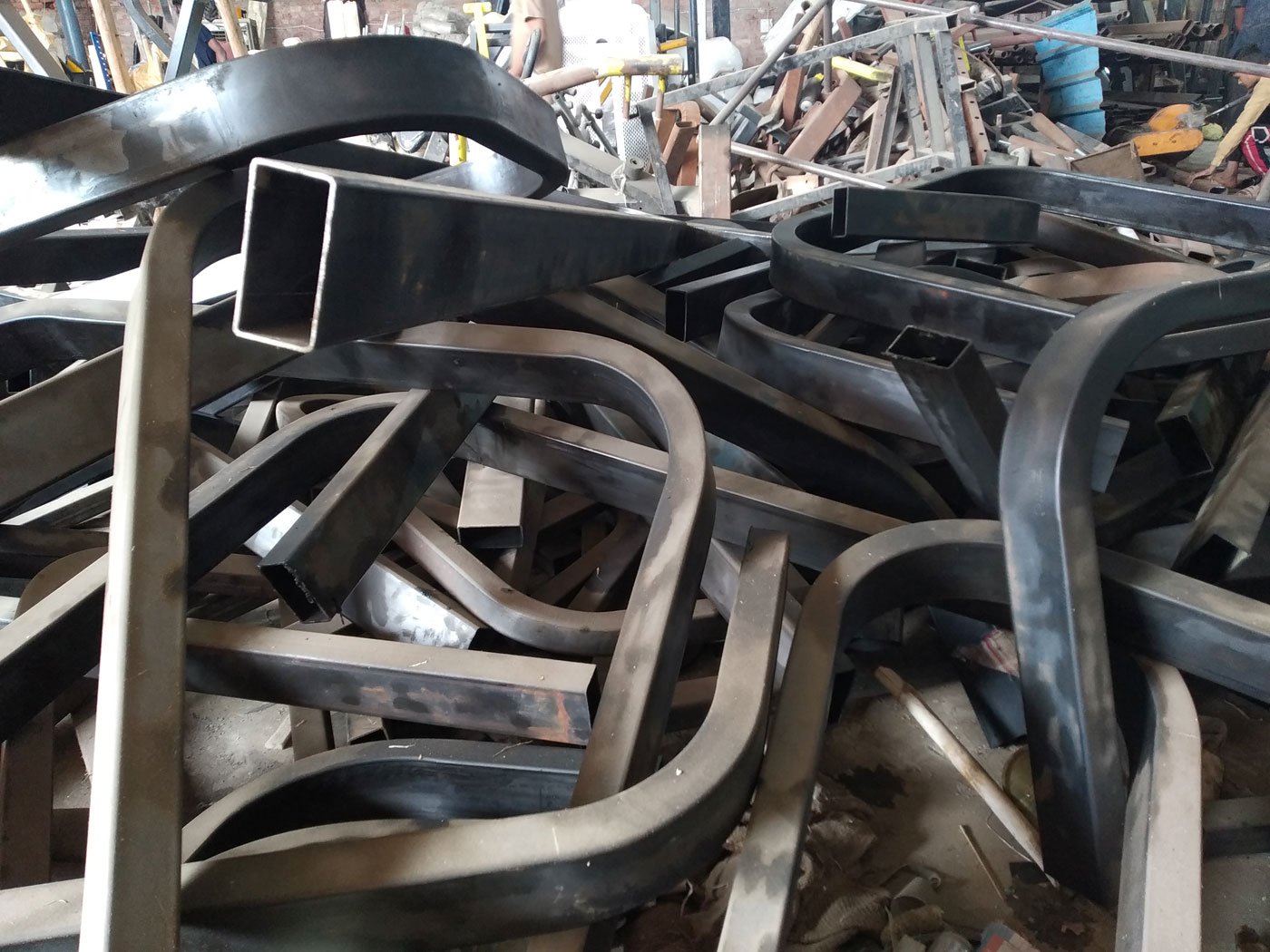

Left: Metal pieces are cut, welded, buffed, finished, painted, powder-coated and packed in smaller parts which are later assembled and fitted together. Right : A band saw cutting machine used to slice solid iron cylindrical lengths into smaller weight plates

The factory workers dressed in colourful t-shirts operate electric machines that radiate sparks when brought in contact with metal
“For gym equipment, metal parts need to be cut, welded, buffed, finished, painted, powder coated and packed. Smaller parts are later assembled and fitted together,” Saqib explains as we move around the factory. “A lay person will not understand which part is being made because they have only seen the fitted and fancy equipment in an airconditioned place.”
The gyms he is describing are a far cry from the factory floor we are in. Housed in a structure with three walls and tin sheds overhead, the factory in Tatina Sani is segregated into three work zones – the fabrication area, the painting area and the packing area. The open end allows for some air circulation – a critical need for the long months of summer when temperatures hover around 40 and even rise above 45 degrees Celsius.
As we walk around the shop floor, we need to pay special attention to where we step.
Iron rods and pipes measuring 15 feet in length, solid iron cylindrical lengths weighing more than 400 kilograms, dense and flat metal sheets used for cutting out weight plates, electrically operated large machines and gym equipment in various stages of production are all over the floor. There is a narrow, unmarked trail, but miss it and you run the risk of a painful cut from a sharp edge and even a broken bone from something heavy falling on your feet.
Amidst all of this unmoving brown, grey and black of heavy material, the only movement and brightness comes from the workers. Dressed in colourful t-shirts, they are operating electric machines that radiate sparks when brought in contact with metal.
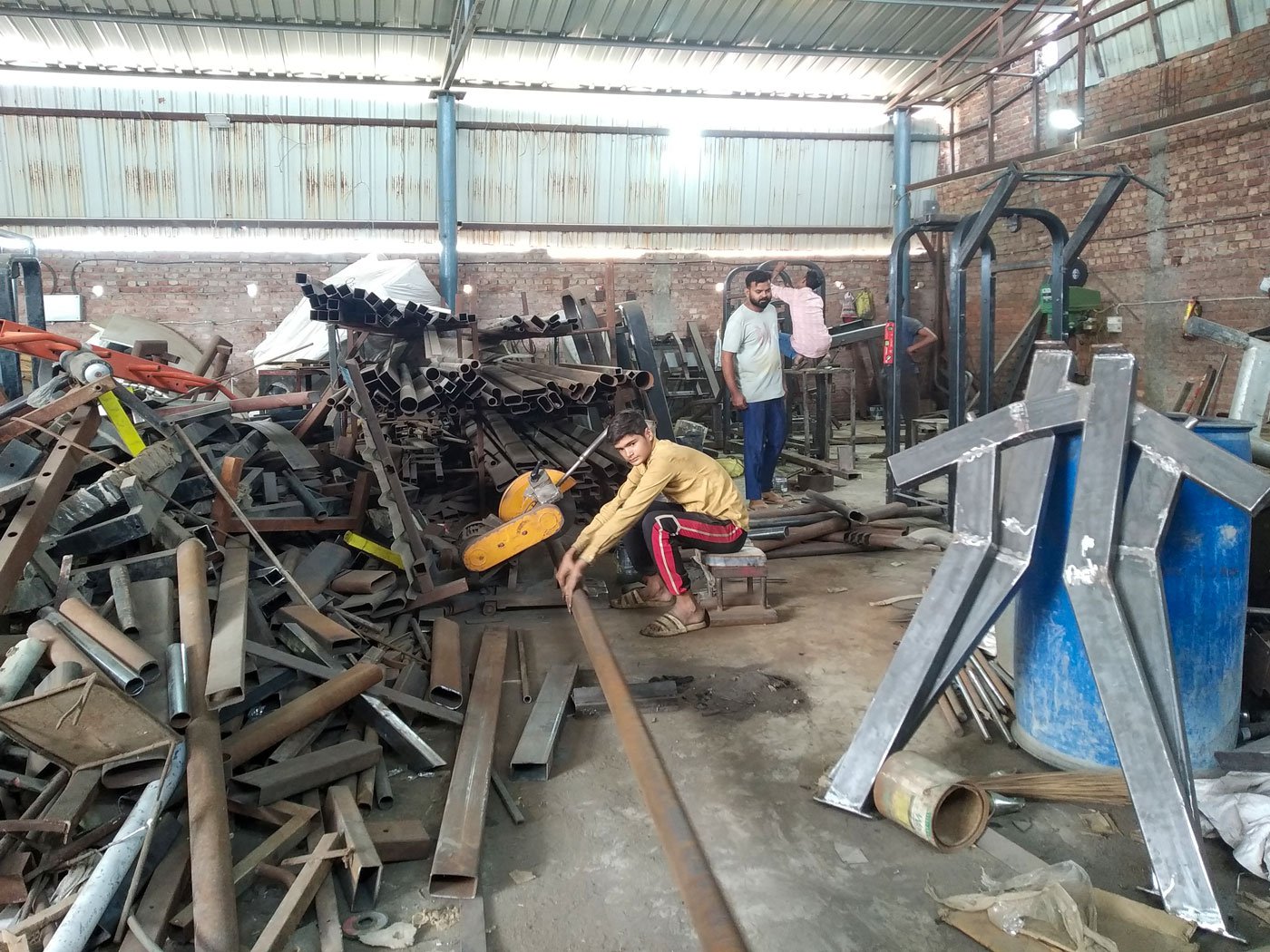

Asif pushes the iron pipe along the empty floor on his left to place it on the cutting machine; he cuts (right) the 15 feet long iron pipe that will go into making the 8 station multi-gym

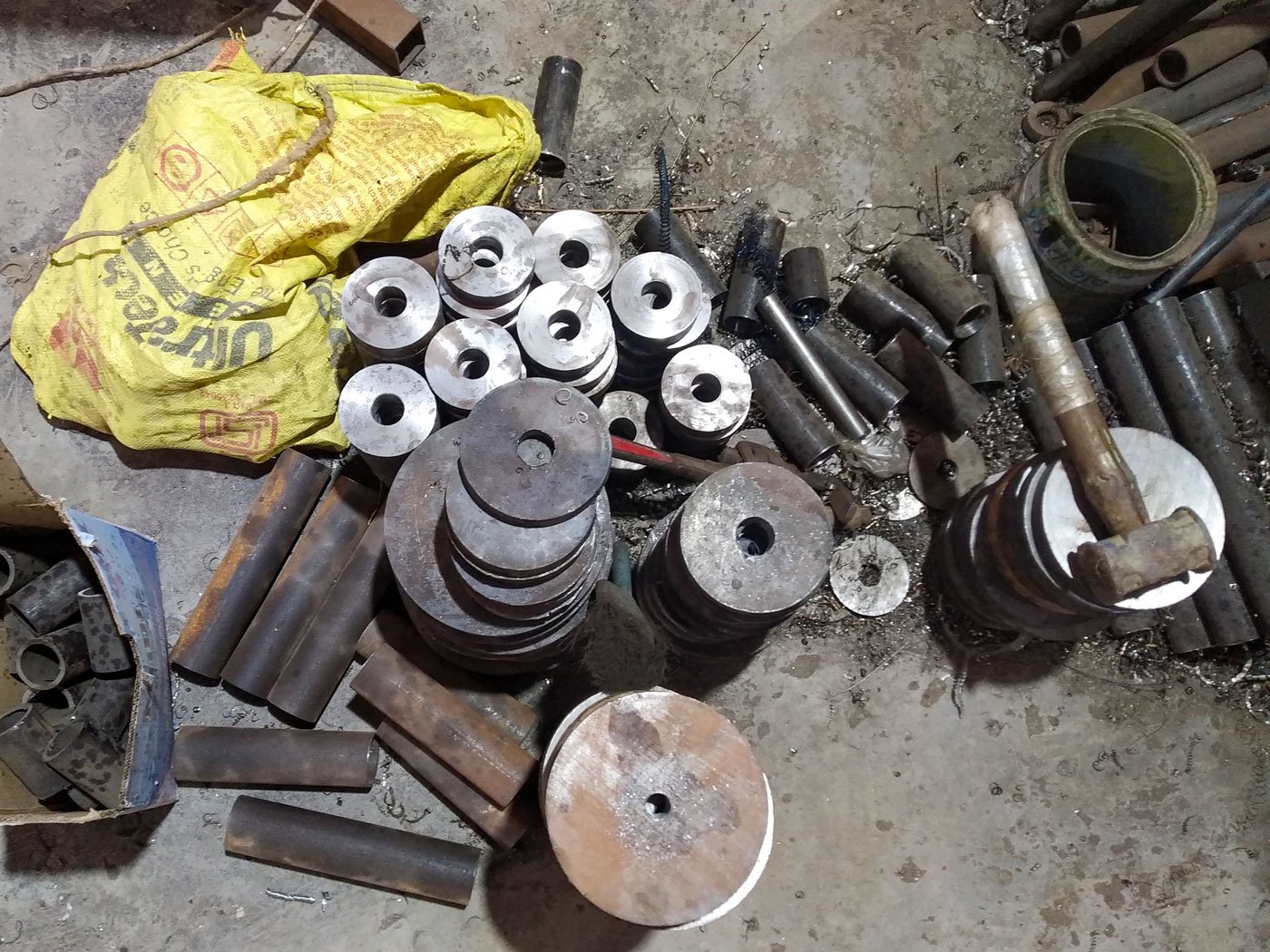
Left:
Mohammad Naushad, the lathe machine
technician at the factory, is in-charge of cutting and shaping the cut cylindrical
iron and circular metal sheet pieces into varying weights.
Right: At Naushad's station,
several disc-shaped iron pieces stacked on top of one another based on
their weight
Mohammad Asif is the only worker here from Tatina Sani; others come from neighbourhoods in and around Meerut city. “I have been working here for two and a half months, but this is not my first job. I used to work in another gym machine factory before this,” says 18-year-old Asif, who is the iron pipe cutting expert. Pulling out the 15 feet long pipes from the unkempt pile, he pushes them along the empty floor on his left before placing them on the pipe-cutting machine one by one. He uses an inch tape to mark parts where cuts have to be made based on the length and design requirements for the gym equipment in-making.
“My father drives an auto that he doesn’t own,” Asif continues, “his earnings are not enough so I had to start working as soon as I could.” He earns a monthly wage of Rs. 6,500.
In another part of the factory, Mohammad Naushad is slicing a solid iron cylindrical piece on a band saw-cutting machine. The 32-year-old is also the lathe machine technician here and has been working with Asim since 2006. “All of these will be attached to different kinds of gym equipment for lifting,” Naushad says, pointing to several disc-shaped iron pieces at his station which are arranged on top of one another based on their weight. Naushad earns Rs. 16,000 per month.
Left of Naushad’s workstation sit Mohammad Asif Saifi, 42, and Amir Ansari, 27, who are putting together an eight station multi-gym which is part of a consignment that has to be delivered to an army camp in Kupwara (Jammu and Kashmir).
The company’s clients include Indian Army
establishments in Srinagar and Katra (J&K), Ambala (Haryana), Bikaner
(Rajasthan) and Shillong (Meghalaya) and “the list for private gym setups range
from states like Manipur to Kerala. We export to Nepal and Bhutan as well,”
Saqib adds.
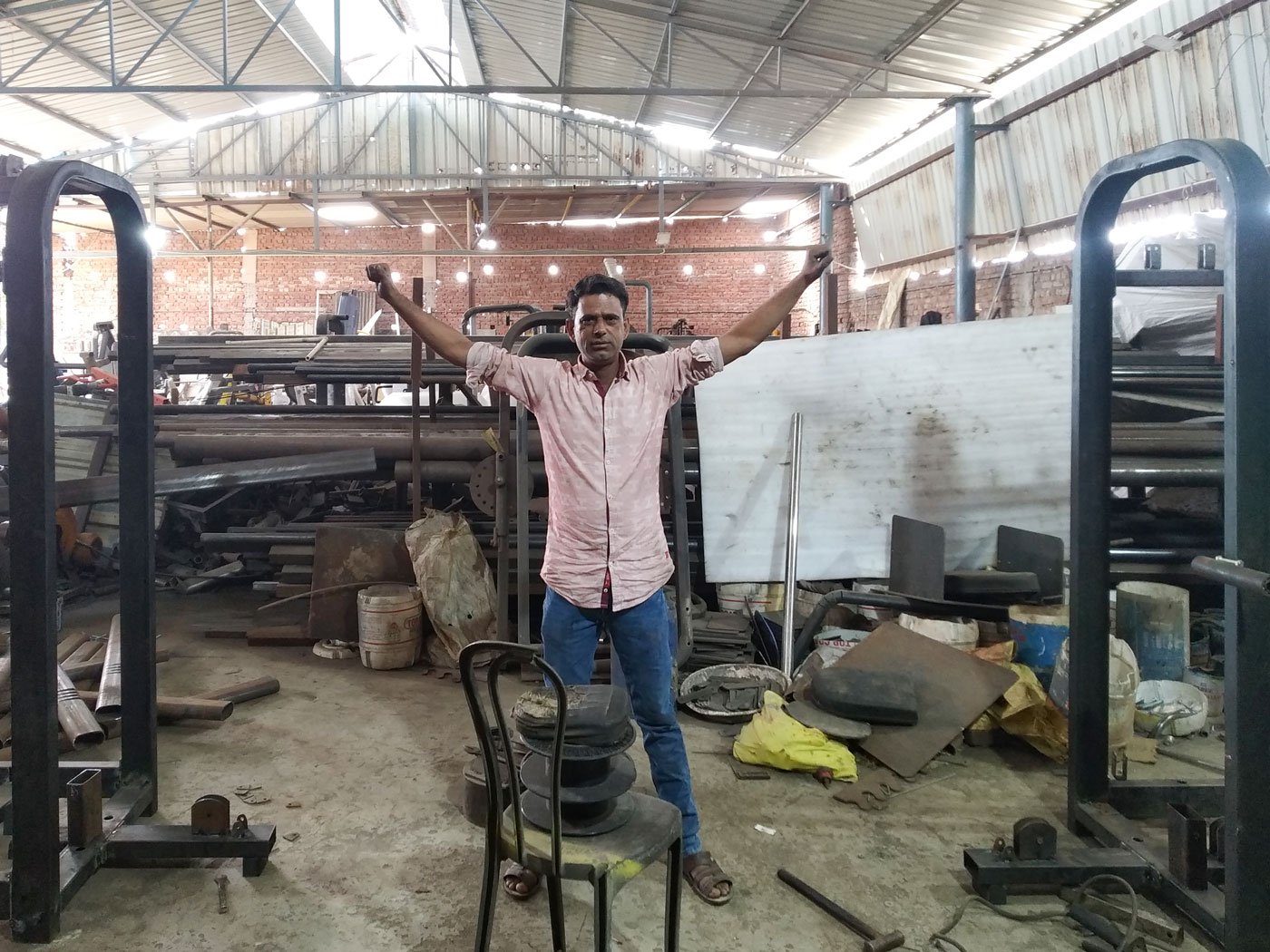

Left:
Asif Saifi finalising the distance between two ends of the
multi-gym based on the cable crossover exercise. Right: He uses an arc welder to work on the base of the multi-gym

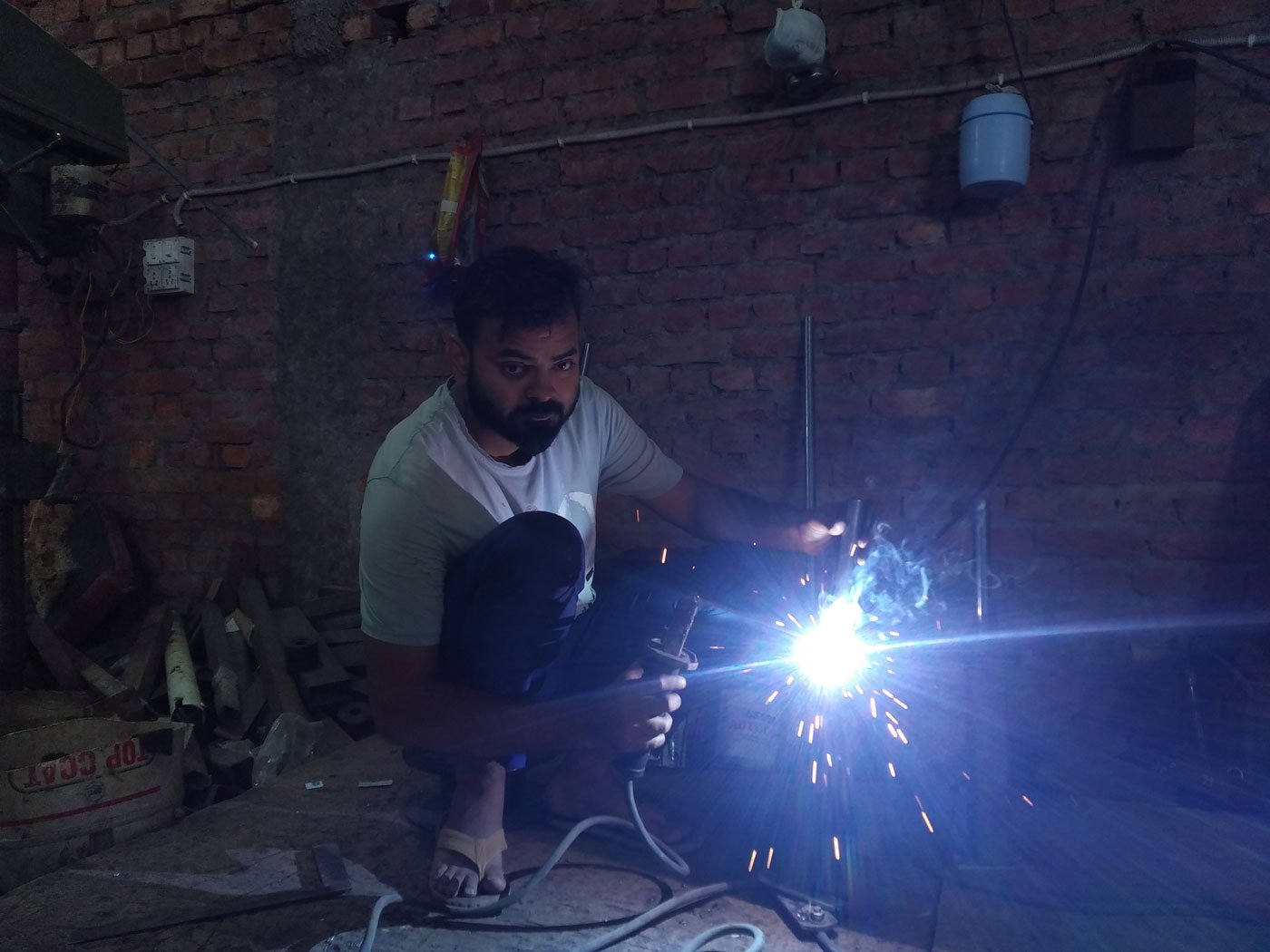
Amir uses a hand operated drilling machine (left) to make a hole into a
plate that will be welded onto the multi-gym.
Using an arc welder (right), he joins two metal pieces
The two are arc welding specialists and work on making smaller parts as well as the assembly of larger equipment. They earn roughly Rs. 50-60,000 a month depending on the orders and number of machines they can make.
“The arc welding machine has a thin electrode in front which penetrates through thick iron and melts it,” Amir explains, and adds, “during the process of joining two pieces of metal, the electrode has to be manually manipulated with a steady hand, which makes it a difficult skill to learn and master.”
“Amir and Asif work on theka [contract],” Saqib explains their wage structure, “the tasks that require the highest skill are done on theka unlike those requiring fewer skills. The experts are high in demand and have a bargaining power for better wages,” he adds.
Suddenly, the glow around the shop floor dims. There is a power cut; work stalls for a few seconds while the factory’s generator is switched on. To make themselves heard over the noise of the generator as well as the electrical machines, workers are now shouting at the top of their voices.
At the next workstation, Ibad Salmani, 21, is strengthening the joints of gym equipment parts with a Metal Inert Gas (MIG) welder. “The iron will melt if you don’t know the different temperatures at which thin and thick pieces have to be welded,” Ibad says. He earns Rs. 10,000 a month.
Bending down to work on the metal piece, Ibad
uses a hand shield to protect his eyes and arms from the sparks generated in
the process. “We have all the protective gear. Workers use them according to
their own assessment of what is safe, unsafe, convenient and inconvenient,”
Saqib says.
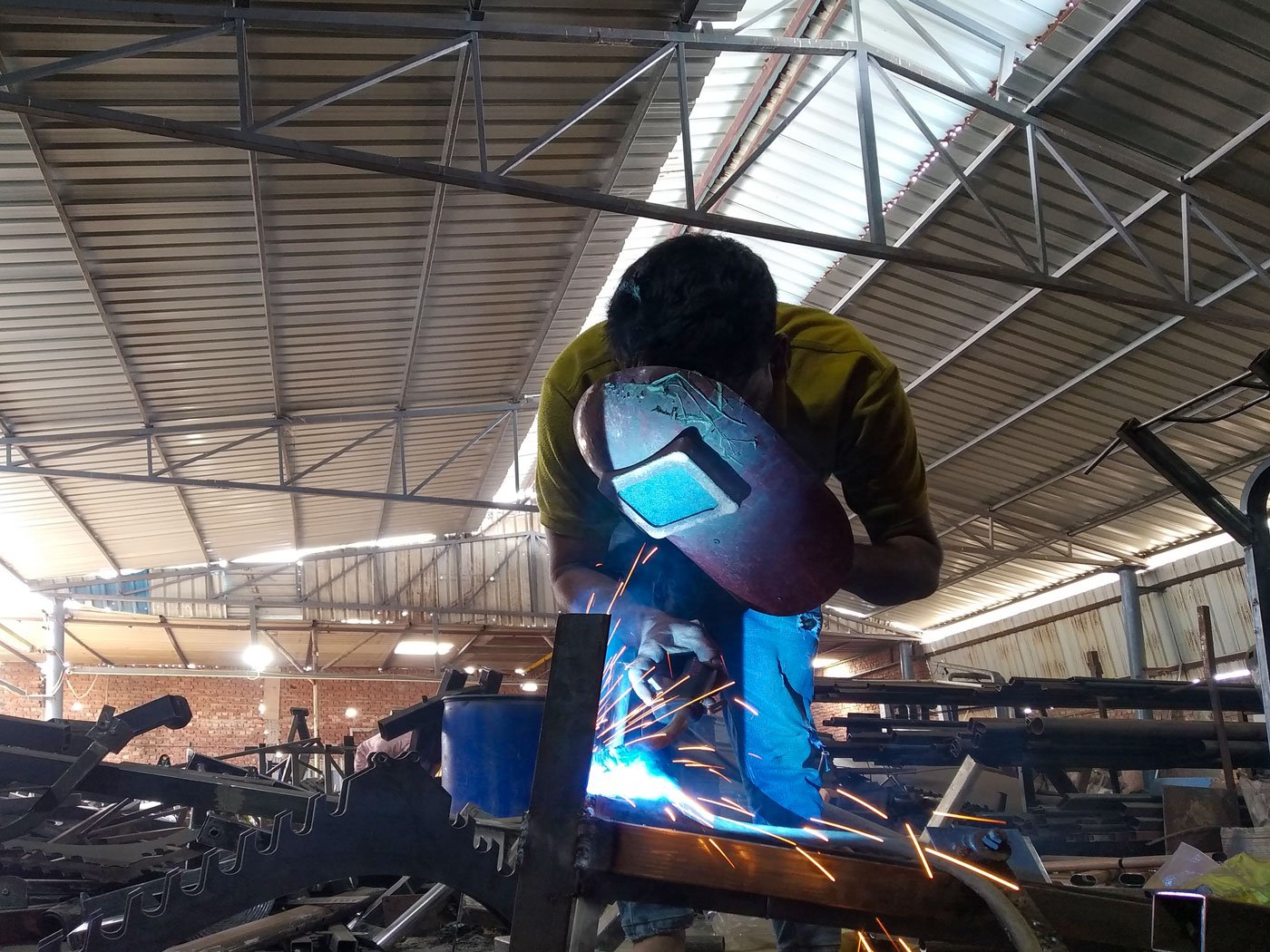

Left: Ibad Salmani uses a hand shield while strengthening the joints of gym equipment parts with a Metal Inert Gas (MIG) welder. Right: Babu Khan, 60, is the oldest karigar at the factory and performs the task of buffing, the final technical process
“Our fingers get burnt; iron pipes fall on our feet. Cuts are ordinary injuries,” Asif Saifi says, and adds nonchalantly, “we are used to it since our childhood. Quitting this work is not an option for us.”
The oldest karigar Babu Khan, 60, covers his forearms with pieces of cotton cloth and ties a larger piece around his waist to protect his torso and legs from the sparks. “I used to do iron rod welding when I was younger in another gym equipment factory, but now I undertake the task of buffing,” he says.
“Buffing is the last technical process which removes abrasions that have come about on the metal surface in the processes of cutting and welding,” Saqib explains. Babu earns a monthly wage of Rs 10,000.
After the surfaces have been smoothened, Shakir Ansari, 45, takes charge of applying body filler putty to cover the joints of equipment parts and smoothens them with regmal (sand paper). Shakir is Saqib’s brother-in-law and has been working here for six years. He works on theka and earns up to Rs 50,000 a month. “I had my own manufacturing business of iron nozzles for diesel-run autos. But after Compressed Natural Gas (CNG) autos entered the market, my work collapsed completely,” he says.
Once Shakir finishes by applying primer and paint on the equipment, it is mechanically powder-coated, “which makes it durable and rust-free,” Saqib explains.
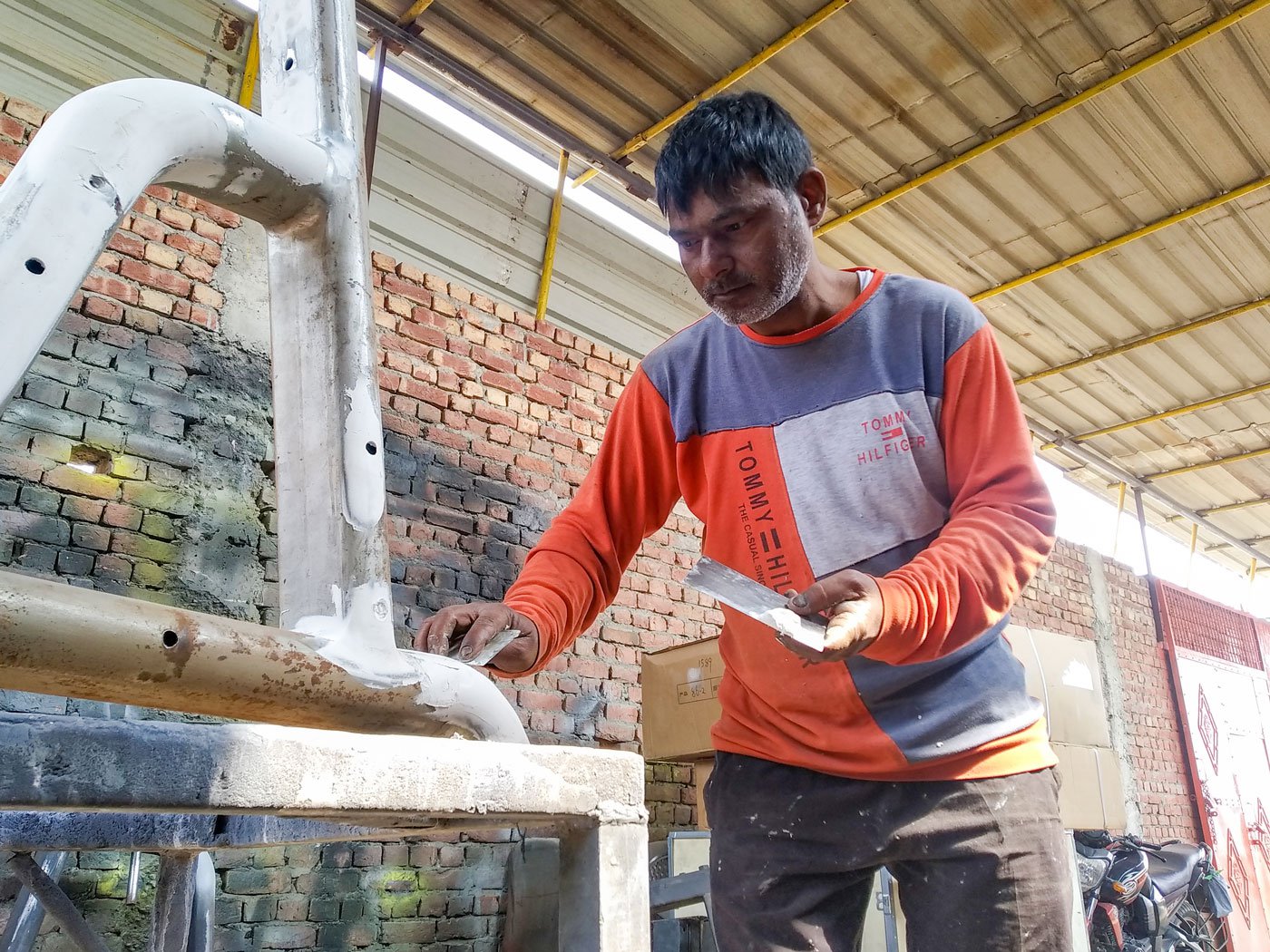
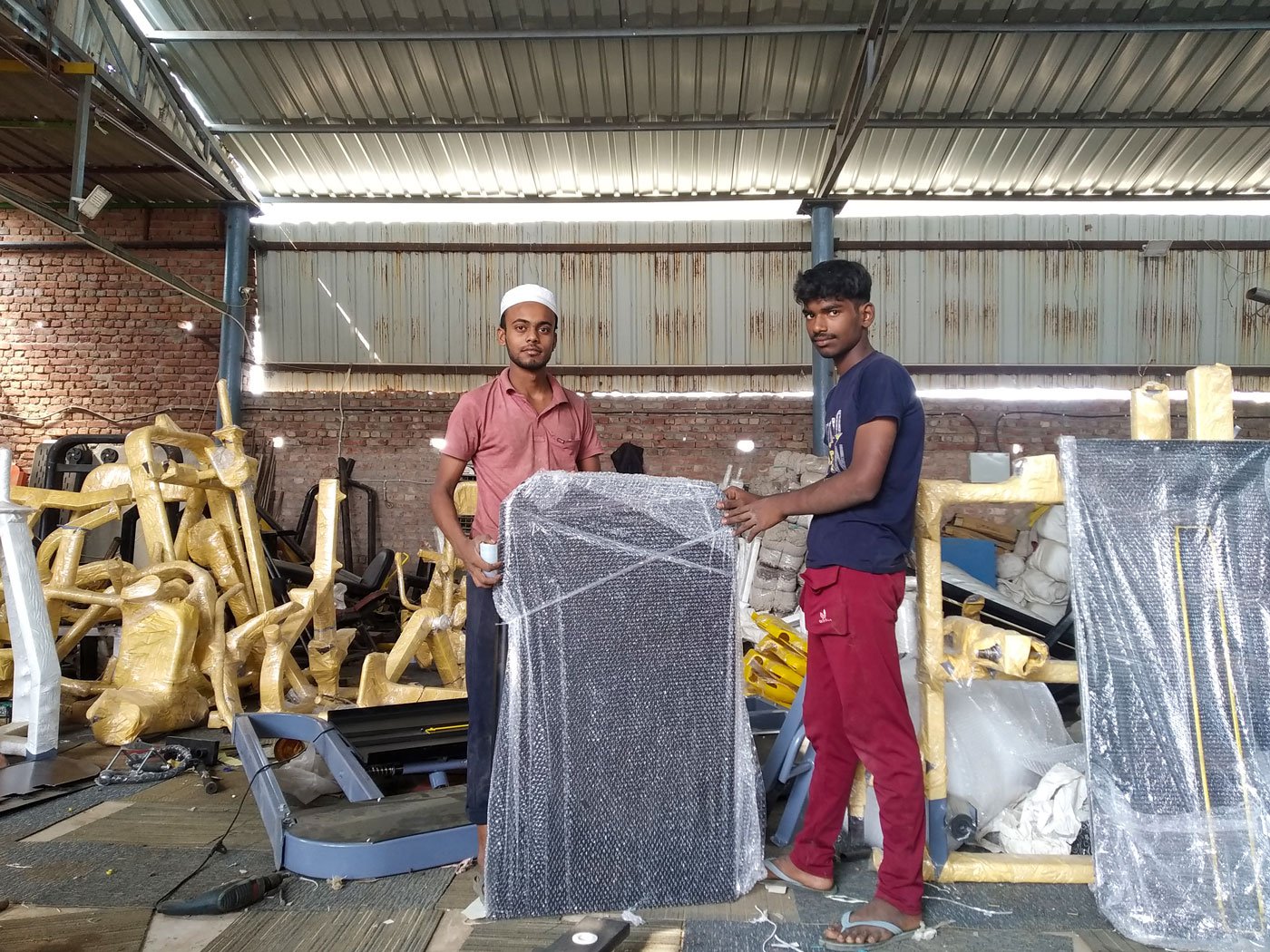
Left: Shakir Ansari applies body filler putty to cover gaps on the surface at the joints. Right: Sameer Abbasi (pink t-shirt) and Mohsin Qureshi pack individual parts of gym equipment
All the newly created equipment parts are separately packed in an area close to the gate from where they are loaded onto trucks for transportation. The team of packers and fitters Mohammad Adil, Sameer Abbasi, Mohsin Qureshi and Shahbaz Ansari are between 17–18 years of age and they each earn Rs 6,500 a month.
The truck to Kupwara for the army gym has arrived and they need to begin loading it.
“Wherever the order goes by truck, we go by train for assembling the equipment,” Sameer says, and adds, “because of this work only, we have been able to see the hills, the oceans and the desert.”
This story is supported by a fellowship from Mrinalini Mukherjee Foundation (MMF).
